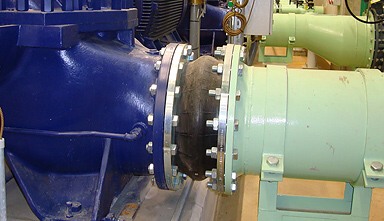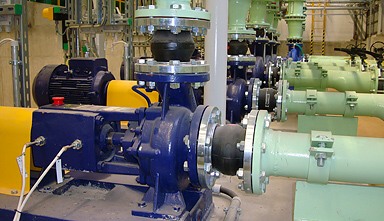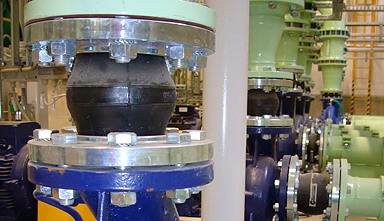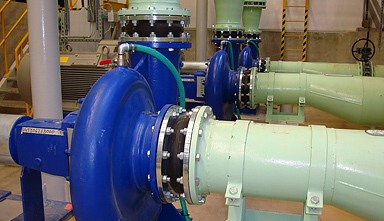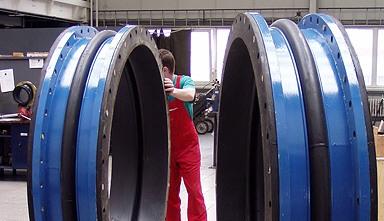Rubber expansion joints
General information Types of rubber expansion joints Type of PTFE expansion jointsData sheet for specification of expansion joints Catalogue
General information
- Rubber expansion joints are flexible „bellows“ manufactured by vulcanization of rubber mixture together with reinforced textile, or steel yarns
- For increase of pressure resistance of rubber expansion joints is inserted in middle wall of bellows a reinforcement from textile or steel yarns
- Rubber expansion joints are with swivel – galvanized flanges, fixed flanges, or threaded fittings with BSPP threads.
- Rubber expansion joints are manufactured in dimensions from DN20 to DN2400 mm
- Thermal resistance of rubber expansion joints is from -25°C up to max. 130°C, depending on material of used rubber and inside reinforcement of expansion joint
- Pressure resistance of rubber expansion joints in standard version is PN 6, 10 and 16 (nominal pressure is at temperature 20°C). Pressure resistance depends from type and dimesnion and max. working temperature of medium. At working pressure of medium higher than 50°C is necessary to correct pressure resistance of expansion joint. Size of correction depends from type of expansion joint and material of „bellows“
Use of rubber expansion joints
Rubber expansion joints are used for elimination of thermal dilatation in pipelines. The largest range of applications they found in vibration damping applications, vibration and noise from pumps and other vibrating pipe aggregates.Construction
- Rubber expansion joint consist from rubber bellows both sides with flanges or threaded fittings. Flanges are swivel or fixed (drilled together with sealing surface of rubber bellows).
- Expansion joints could be delivered with tie-rods – axial reaction force limiters. The design depends on the strain (movements) of expanion joint
| CR - 1M | CR - 3M | CR - 5M | |||
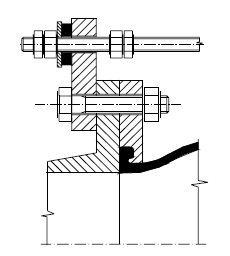 |
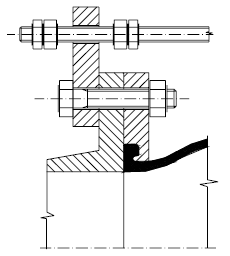 |
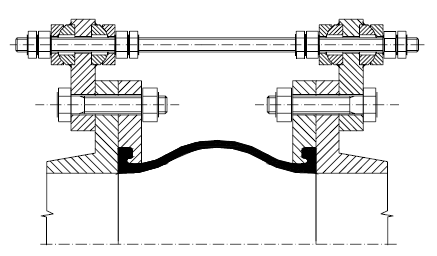 |
Material of rubber expansion joints
1. Rubber „bellows“ are manufactured from materials according to below mentioned table|
Typy |
colour |
material | resistance | temperature |
|---|---|---|---|---|
|
CR |
blue |
Neoprén Chloroprene |
atmospheric effects, ozone, sea water, salt solutions, weak acids, occasional contact with fuel without aroma oils |
-35 °C+ 82°C |
|
EPDM |
red |
EPDM Ethylene-propylene |
warm air, hot water, ozone, various chemical substances without strong solvents, oils and acids |
-35 °C+ 121°C |
|
NBR |
yellow |
Buna-N / Nitril Nitril-butadiene |
fuels and mineral oils containing up to 30% aromatic, natural gas |
-35 °C+ 99°C |
|
CSM |
green |
hypalon |
chemicals in general, including strong and weak acids with the exception of mineral, herbal and aromatic oils |
-35 °C+ 107°C |
|
IR |
white |
natural rubber |
food products, drinking water, except for vegetable oils |
-35 °C+ 92°C |
2. Flanges
- Carbon steel galvanized, or with paint coating
-
Stainless steel
- Cast iron – galvanized
- Stainless steel
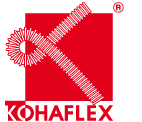
 English
English Slovensky
Slovensky